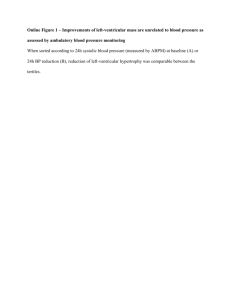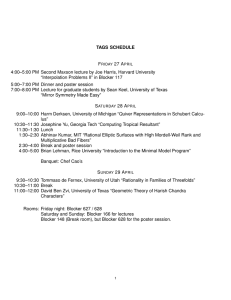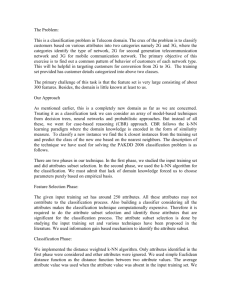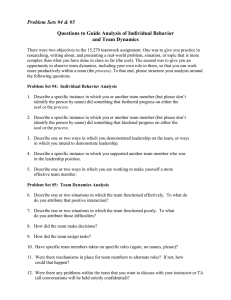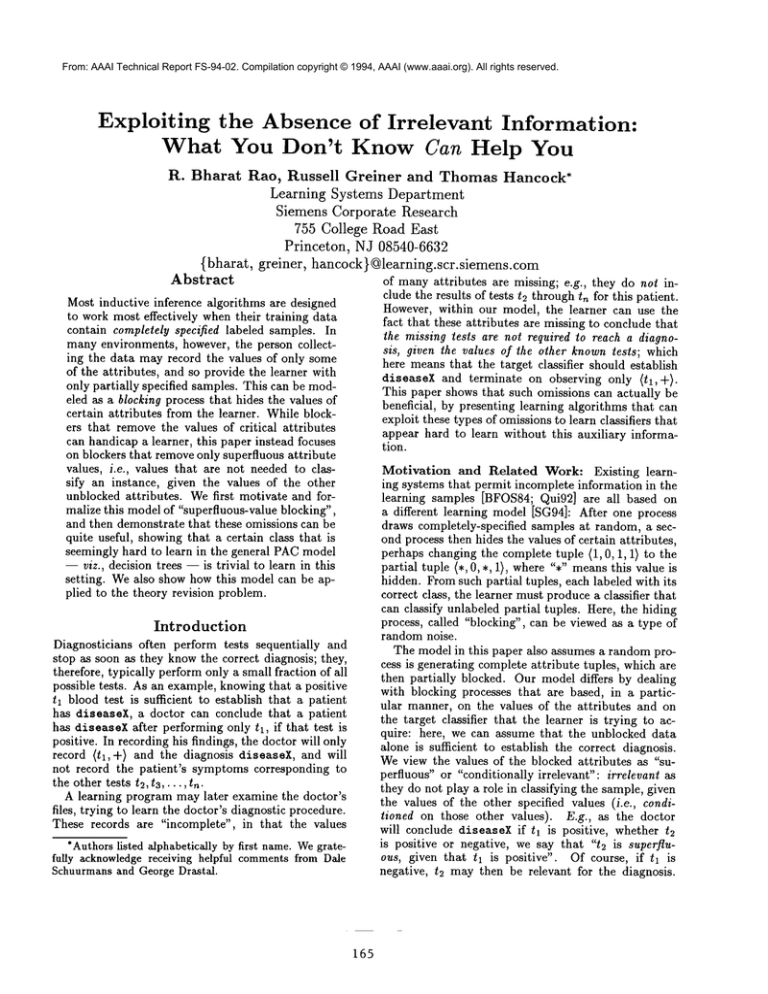
From: AAAI Technical Report FS-94-02. Compilation copyright © 1994, AAAI (www.aaai.org). All rights reserved.
Exploiting
the Absence of Irrelevant
Information:
What You Don’t Know Can Help You
R. Bharat
Rao, Russell
Greiner
and Thomas Hancock*
Learning
Systems Department
Siemens Corporate
Research
755 College Road East
Princeton,
NJ 08540-6632
{bharat,
greiner,
hancock}@learning.scr.siemens.com
Abstract
of many attributes are missing; e.g., they do not include the results of tests t2 through tn for this patient.
Most inductive inference algorithms are designed
However, within our model, the learner can use the
to work most effectively when their training data
fact that these attributes are missing to conclude that
contain completely specified labeled samples. In
the missing tests are not required to reach a diagnomanyenvironments, however, the person collectsis, given the values of the other known tests; which
ing the data may record the values of only some
here means that the target classifier should establish
of the attributes, and so provide the learner with
diseaseX and terminate on observing only (tl,+).
only partially specified samples. This can be modThis paper shows that such omissions can actually be
eled as a blocking process that hides the values of
beneficial, by presenting learning algorithms that can
certain attributes from the learner. While blockexploit these types of omissions to learn classifiers that
ers that removethe values of critical attributes
appear hard to learn without this auxiliary informacan handicap a learner, this paper instead focuses
tion.
on blockers that removeonly superfluous attribute
values, i.e., values that are not needed to clasMotivation and Related Work: Existing learnsify an instance, given the values of the other
ing systems that permit incomplete information in the
unblocked attributes. Wefirst motivate and forlearning samples [BFOS84; Qui92] are all based on
malize this modelof "superfluous-value blocking",
a different learning model [SG94]: After one process
and then demonstrate that these omissions can be
draws completely-specified samples at random, a secquite useful, showing that a certain class that is
ond process then hides the values of certain attributes,
seemingly hard to learn in the general PACmodel
perhaps changing the complete tuple (1, 0, 1, 1) to the
-- viz., decision trees -- is trivial to learn in this
partial tuple (*, 0, *, 1), where "*" meansthis value
setting. Wealso show how this model can be aphidden. From such partial tuples, each labeled with its
plied to the theory revision problem.
correct class, the learner must produce a classifier that
can classify unlabeled partial tuples. Here, the hiding
process, called "blocking", can be viewed as a type of
Introduction
random noise.
Diagnosticians often perform tests sequentially and
The model in this paper also assumes a random prostop as soon as they knowthe correct diagnosis; they,
cess is generating complete attribute tuples, which are
therefore, typically perform only a small fraction of all
then partially blocked. Our model differs by dealing
possible tests. As an example, knowingthat a positive
with blocking processes that are based, in a partictl blood test is sufficient to establish that a patient
ular manner, on the values of the attributes and on
has diseaseX, a doctor can conclude that a patient
the target classifier that the learner is trying to achas diseaseX after performing only tl, if that test is
quire: here, we can assume that the unblocked data
positive. In recording his findings, the doctor will only
alone is sufficient to establish the correct diagnosis.
record (tl,+) and the diagnosis diseaseX, and will
Weview the values of the blocked attributes as "sunot record the patient’s symptoms corresponding to
perfluous" or "conditionally irrelevant": irrelevant as
the other tests t2, t3, ¯ ¯., tn.
they do not play a role in classifying the sample, given
A learning program may later examine the doctor’s
the values of the other specified values (i.e., condifiles, trying to learn the doctor’s diagnostic procedure.
tioned on those other values). E.g., as the doctor
These records are "incomplete", in that the values
will conclude diseaseX if tl is positive, whether t2
is positive or negative, we say that "t2 is superflu¯ Authorslisted alphabetically by first name.Wegratefully acknowledgereceiving helpful commentsfrom Dale
ous, given that tl is positive". Of course, if tl is
Schuurmansand George Drastal.
negative, t2 may then be relevant for the diagnosis.
165
"RealWorld"
P(.)
(~,c(~))
Blocker
Figure 1: Model of Blocking Process
Most other research that deals with learning in the
context of irrelevant attributes [Lit88; Blu92; AD91;
BHL91]considers the stronger claim that an attribute
is irrelevant only if its value never plays a role in the
1classification, for any values of the other features.
Implemented learning systems that can handle missing features tend to work effectively when relative few
feature values are missing, and when these missing values are randomly distributed across the samples. However, recent studies [PBH90; RCJ88] have shown that
in practice many datasets are missing more than half
of the feature values! Moreover, these attribute values are not randomly blocked, but in fact "are missing
[blocked] whenthey are knownto be irrelevant for classification or redundant with features already present in
the case description" [PBH90], which is precisely the
situation considered in this paper (see Definition 2).
Our model of learning may therefore be applicable to
manydiagnostic tasks, and will be especially useful
where experts are not available, or are unable to articulate the classification process they are using.
that has small error, where the error of h is defined as
Err(h)
:
~ P(x)
~eX~,h(~)¢c(~)
which is the probability that the returned hypothesis h
will misclassify an instance x drawn from the distribution P. We use the standard PACcriterion [Va184;
KLPV87]to specify the desired performance of our
learners:
Definition
1 (PAC learning)
Algorithm L PAC
learns a set of concepts C if, for some polynomial function p(...), for all target concepts c E C, distributions
P, and error parameters, 0 < e, 6 < 1, when L is
run with inputs e, 6, and a random example oracle
EX (where each call to EX returns an instance independently chosen according to distribution P and labeled according to c), L terminates in time at most
1 1
p(~,
~, leD,where
Icl is the"size"of the concept e, and
outputs a hypothesis h E C whose error is, with probability at least 1 - 6, at most e; i.e.,
VP E "distr. on Xn ", c E C, O < e, 6 < 1,
Pr(Err(h)<e)
> 1-6.
Framework
Model of "Blocked Learning": In standard learning models, each labeled instance (x, c(z)) is passed "as
is" to the classifier. In our model the learner instead
only sees a "censored" version of (x,c(x)), written
"(~(x), c(x))", based on a blocker fl which is a function
that maps an instance x E {0, 1}" to a blocked instance
fl(x) E {0, 1,*}n; see Figure 1. The value "." denotes
the the corresponding attribute is blocked. Hence,
a blocker could map((1, 1, 0, 1), T) to ((1, *, *, *),
or ((*, 1, 0, *), F), but not to either ((1, 0, 0, 1),
((1, 1, 0, 1),*). Let An*= {0, 1,*}" denote the set
possible instance descriptions.
This paper considers only superfluous-value blockers:
i.e., blockers that block only attribute values that do
not affect an instance’s classification, given the values
of the other unblocked attribute values. (Therefore,
for superfluous value blockers, "*" is equivalent to a
"don’t care" value.) To state this more precisely:
Standard Model of Learning: Following standard
practice, we identify each domain instance with a finite vector of boolean attributes x = (xl,..., Xn), and
let Xn -- {0, 1}n be the set of all possible domaininstances. The learner is trying to learn a concept which
we view as an indicator function c : X~ ~-* {T, F},
where x is a member of c iff c(x) -- T. 2 A "(labeled) exampleof a concept c E C’ is a pair (x, c(x))
Xn × {T, F}. Weassume that random labeled instances
are drawn independently from a stationary distribution
P: Xn~-* [0, 1].
A learning algorithm has access to an oracle, EX,
for random examples that, when called, will provide
(in unit time) a labeled example (x, c(x)) where x is
drawn according to P and labeled by c. The learning
algorithm’s goal is to produce as output a concept h
1Other research [JKP94]extends the traditional notion
of irrelevance, to handle correlated attributes.
2Tosimplify our presentation, we will assumethat each
attribute has one of only two distinct values, {0, 1}, and
that there are only two distinct classes, written {T, F}. It
is trivial to extendthis analysis to considera larger (finite)
range of possible attribute values, and larger (finite) set
classes.
Definition 2 ( "Superfluous"/"Conditionally
Irrelevant"
Given a concept c E C over the set of attributes
{Xl,,,,,x~}:
1. The attributes {x,~+l,..., x~} are superfluous given
the partial assignment {Xl ~-* Vl, ..., xm ~ vm}
(where each vi E {0, 1} is a specified value) iff
L
166
Vi = (m + 1)..n, Yi E {0, 1}:
c((vl,...,Vrn,Yrn+l,...,yn))
~- c((vl,..-,Vm,0,...,0/)
2. a function fl: Xn ~-* X* is a legal superfluous-value
blocker if it only blocks superfluous attributes; i.e.,
if l3((vx,...,vn))
= (vl,...,Vm, *,..., *) implies
attributes {Xm+a,..., xn } are superfluous given the
partial assignment{xl ~-+ vl, ..., Xrn ~-+ Vrn}.
tree. Weconsider the blocker that suppresses those attributes that do not appear on an instance’s evaluation
path in the target decision tree. Webegin with the
simplest situation, and progress to successively more
complicated situations. For notation, let :DT-n be the
set of decision trees defined over n boolean variables,
To better clarify our notion of "superfluous", consider the situation where X, = {0, 1}2 is the set of all
possible domain instances and the target concept c is
represented by the boolean formula xl V x2. Then a legal blocker could mapthe instance ((1, 1), T) either
((1, *>, T) or to ((*, 1), T), meaning"x2 is superfluous,
given that xl is positive" and vice versa. Hence, for
this single instance, either xl or x2 can be conditionally
irrelevant, depending on the tests that have already
been performed. Therefore, our notion of (it)relevance
depends on both the instance being filtered and on the
blocker that is employed.
In general, there can be manypossible superfluous
value blockers for a given concept (including the degenerate no-op blocker that reveals every attribute).
Wemust therefore specify the blocking scheme B that
maps each concept c E C to its superfluous value
blocker /3 = B(c). This paper focuses on blocking
schemes which correspond to an evaluation procedure
that takes an instance and a target concept, and runs
until the value of the target is determined, leaving
unblocked just those attributes that are examined by
the evaluation procedure. For example, the natural
blocking scheme for decision trees is one that evaluates an instance on the target tree and reveals only
those attributes that were tested on the root-to-leaf
path taken by the instance.
Our model is otherwise the same as the PACmodel.
In particular, the learner’s task is still to acquire a
classifier that has high accuracy on completely specified
instances. (This objective is reasonable as the classifier
can specify the tests to be performed. Recall, however,
the learner only sees training instances that have been
filtered through a legal blocker.)
Wesay that "a concept class C is learnable with
respect to the blocking scheme B" if there is a
learning algorithm L that achieves the PAC criterion shown in Definition 1, with the sole modification that L uses the blocked-oracle EX~(c), where on
each call, EXB(c) returns the labeled blocked instance
(B(c)(x), c(x)) E An* x {T,F}, rather than the usblocked (x, e(x)) E Xn x {T, F) EX would have
returned. (I.e., EXB(¢)first filters the instance through
the/3 = B(c) filter associated with target concept c.)
Empty Initial
Tree: The DT[E] model assumes that
the learner begins with an Emptyinitial decision tree,
which is extended into a full decision tree based on a
set of samples, and that the blocker uses the target
decision tree dT to block attributes of the instances.
On receiving a complete instance, x = (xl,...,xn),
the blocker traverses the dT decision tree, from the root
down, recording not just the appropriate classification
for this instance tiT(X) E {T,F}, but also the set
of tests that were performed; this corresponds to the
path through dT. The blocker then passes on only the
attributes encountered on the path, and blocks all the
other attributes.
The simple GRowDT,algorithm,
shown in Figure 2, can learn decision trees from these blocked instances in the DT[E]model. The critical observations
are that the root of the target tree can never be blocked
and that any variable that is never blocked appears
on the path to every leaf reached by the sample and
hence can be placed at the root. 3 After GRowDT
has collected "enough" samples, it calls BUILDDT
to
find the best tree, given those samples. BUILDDT
first
selects as its root any attribute value that is never
blocked, then splits on this attribute, and calls itself
4recursively.
Results
for Decision Trees
This section discusses the challenge of learning decision
trees within this "superfluous blocking model". Decision trees have a natural blocking strategy since each
exampleis classified by a unique root-leaf path in the
167
x~.
Theorem 1 For any target tree co E OTn, any values
of e, 6 E (0, 1) and any distribution, under the DT[E]
model, GRowDT(
n, ¢, 6 ) will, with probability at
least 1 - 6, return a tree c I E 7)7-n, whoseerror is at
most e. Moreover, GRowDTrequires O(]co]£1n(g))
samples, and returns a tree of size ]ct[ < ]co], where°lc]
is the numberof nodes in c.
Wesee here the advantage of exploiting these superfluous values, as there is currently no knownalgorithm
capable of learning decision trees in the standard PAC
5model.
Non-Empty Initial
Tree: In many situations,
we
mayalready have an initial decision tree, di,,it E l)Tn,
3If the blocker also provides additional information
about the order in which tests are recorded, then GRowDT
can be trivially modifiedto learn a tree identical to the dT
decision tree traversed by the blocker.
4While the GRowDT8
algorithm is parameterized by
the size of the tree s, we can produce a modified version
GRowDT
that does not require this parameter by using the
standard technique [HKLW91]
of repeated attempts with
successively doubledestimates of s.
5The best known general algorithms run in pseudopolynomial time, i.e., they learn aa s-node decision tree
in time polynomialin sl°g 8 [EH89].
Algorithm GRowDT,(n: +, e: ( 0,1), 6 : ( 0,1)): T reeType
/* Returns tree of size s that correctly classifies a (large enough)sampleofn-tuples
Draw ms = ~ [sln(8n)+ In(l/b)]
partially-specified
labeled samples, Ss (from the EXB(,) oracle)
Return( BUILDDT(S~ )
End GRowDTs
Algorithm BUILDDT(
S: set_of-partial_samples
): TreeType
/* Builds a tree using samples S */
Let NT be new tree
If (all samples in S are labeled with same t) or (S is empty)
NT.LeafLabel = £ (or "...= T" if IS[ = 0)
Return(NT)
Letxi be any variable
thatis unblocked
foralls 6 S.
Let
So = {(~
- {~do},~)
I(~,e)
¯s,27,1o
¯
S1 = {(27 -- {27i11},£)
I (27,e)
¯ S,~,/1¯ 27}
/* To form sO: Assemblethe instances in S that include the 27,/0 assignment,
then project out that attribute; similarly for S1. */
Let NT.InterndNodeLabel
= 27i
NT.If0= BUILDDT(O )
NT.Ifl= BUILDDT(z )
Return(NT
End BUILDDT
Figure2: BUILDDTAlgorithm
forlearning
decision
trees
which is considered quite accurate, but not perfect. We
can use a set of labeled samplesto modifydi,it; i.e., to
form a newtree dbetter that is similar to di,it, but (with
high probability) more accurate. Welet DT[TR+]refer to this model, where the TR designates "Theory
Revision", corresponding to the manyexisting systems
that perform essentially the same task (typically for
Horn-clause based reasoning systems) [MB88; OM90;
Tow91; WP93; LDRG94].
As before, the real-world continues to generate
completely-specified samples, z, each labeled dT(x)
{T, F} by the target (but unknown) decision tree dT.
Here, however we need a slightly different type of
blocker, which first runs this sample through the initial decision tree dinit, to obtain both a proposed (but
not necessarily correct) label dinit(z) and a particular
set of unblockedattribute values; call this fld,., (z)
X*. If dinit’s
label is correct (i.e.,
if dT(z)
dinit(x)), then the learner receives (fld,.,(x),dT(x)).
Otherwise, if dr(z) # d,..(~), lear ner rece ives
(fld,.,var(z),
dT(z)), where the fld,.,vdr blocker specifies the value of any attribute that is unblocked by
either ~,~,, or ~dT.
The extended
paper [GHR94] presents
the
+ algorithm (an extension of the earlier
MODtFYDT
BUILDDT
algorithm) which can modify an initial decision tree dinit, based on a set of such labeled partially+
specified instances. It also shows that MODIFYDT
can effectively pac-learn the target decision tree.
Learner is also told which attributes
were NOT
needed: Alternatively, the blocker might also specify that some of the attributes that dinit included
are in fact superfluous; i.e., that some of the tests
that were performed should not have been run. The
DT[TR+]model provides this information by using
the ~dr blocker. (As the learner knowsdl,lt, it can de-
168
termine which attributes fld~., would block, if neces± algorithm
sary.) [GHR94] describes the MODIFYDT
that can pac-learn decision trees given such instances.
Extending the "perfect
blocker"
model: Each
of the blockers described above is "perfect", i.e., will
remove all-and-only the superfluous attribute values.
In practice, however, a diagnostician may occasionally
perform a superfluous test or omit a relevant test, or
could even mis-read or mis-record some attribute values. These types of errors can occur, for example, if
different patients are diagnosed by different experts,
each of whomuses his owntree to do the classification.
The extended paper [GHR94]generalizes our "perfect"
model by removing these restrictions,
producing various ~P blockers, each parameterized by the 6-tuple
of probability values, # = (Pre,P~.,P~i,p~c,ps.,p~i),
where
Blocker’svalue is:
Correct
.
Incorrect
Attribute value is
Required Superfluous
Pro
Psc
Pr,
Ps.
Pri
Psi
To explain: Given any target decision tree dT, for each
instance, we can label each attribute value as either required or superfluous. For each required attribute,
stochastically makes a 3-way decision: providing the
attribute’s correct value with probability p~, "," with
probability p~, and the incorrect value with probability P~i (e.g., returning 0 whenthe correct attribute
value is 1). Similarly, if the attribute is superfluous,
will return the attribute’s correct value, the value
"*" or the wrong value, with respective probabilities
psc, ps,, or Psi.
The DT[E] model, discussed above, uses p~¢ = p,, =
1 and the other Pl values all 0; and the traditional
complete-tuple
model uses p~e = p,¢ = 1. We can
use this framework to connect this work with earlier models of attribute noise; in particular,
as [KL88;
SV88] consider erroneous but not missing attribute values, they each assume Pr. = Ps. -- 0.
D. Haussler, M. Kearns, N. Littlestone,
and M. K. Warmuth. Equivalence of models for polynomial learnability.
Inform. Comput., 95(2):129-161, December 1991.
G.H. John, R. Kohavi, and K. Pfleger. Irrelevant features
and the subset selection problem. In Proceedings of the
Eleventh International Conference on Machine Learning,
pages 121-129, 1994.
As a final point, we have considered learning arbitrary DNFformulae when superfluous values are omitted. Here, each blocked instance is simply an implicant of either the target formula ~ or its negation --’in.
There are several different
ways of specifying which
implicant should be returned, including "the smallest
prime implicant", and "the values of the smallest prefix of a single ordering, say (Xl,...,
xn), that qualifies
as an implicant". We present several situations
where
a benevolent blocker (think "teacher")
can make formulae trivial
to learn, and other situations where an
adversarial
blocker can make learning such formulae
as difficult
as learning DNFin the usual "completelyspecified tuple" model.
M. Kearns and M. Li. Learning in the presence of malicious errors. In Proc. 20th Annu. ACMSympos. Theory Comput., pages 267-280. ACMPress, New York, NY,
1988.
Michael
Valiant.
ceedings
tations,
Kearns, Ming Li, Leonard Pitt,
and Leslie
On the learnability of boolean formulae. In Proof the 19th Symposium on the Theory of Compupages 285-295, NewYork, May 1987.
Pat Langley, George Drastal, R. Bharat Rao, and Russ
Greiner. Theory revision in fault hierarchies.
Technical report, SCRTechreport, Siemens Corporate Research,
1994.
Summary
Nick Littlestone.
Learning quickly when irrelevant
tributes abound: A new linear-threshold
algorithm.
chine Learning Journal, 2:285-318, 1988.
Even though most diagnosticians
perform and record
only a small fraction of the set of possible tests to
reach a classification,
most learning systems are designed to work best when their training data contains
completely-specified
attribute-value
tuples. This abstract presents learning algorithms designed to deal
with exactly such partially-specified
instances.
We
show, in particular, that it is easy to "PAClearn" decision trees in this model. We also present extensions to
the underlying model, and suggest corresponding algorithms, to incrementally modify a given initial decision
tree, and provide a framework for discussing various
types of "noise" -- where the blocker can stochastically
omit required values, or include superfluous values.
atMa-
S. Muggleton and W. Buntine. Machine invention of first
order predicates by inverting resolution. In Proceedings of
IML-88, pages 339-51. Morgan Kaufmann, 1988.
Dirk Ourston and Raymond J. Mooney. Changing the
rules: A comprehensive approach to theory refinement.
In Proceedings of AAAI-90, pages 815-20, 1990.
B. W. Porter, R. Bareiss, and R. C. Holte. Concept learning and heuristic classification
in weak-theory domains.
Artificial Intelligence, 45(1-2):229-63, 1990.
J. Ross Quinlan. C~.5: Programs for Machine Learning.
Morgan Kaufmann Publishers, San Mateo, 1992.
K. Ruberg, S.M. Cornick, and K.A. James. House calls:
Building and maintaining a diagnostic rule-base.
In
Proceedings Third Knowledge Acquistion for KnowledgeBased Systems Workshop, 1988.
References
H. Almuallim and T.G. Dietterich.
Learning with many
irrelevant features. In Proceedings of the Ninth National
Conference on Artificial Intelligence, pages 547-552, 1991.
Dale Schuurmans and Russell Greiner.
concepts. In CSSCI-94, 1994.
L. Breiman, J. Friedman, J. Olshen, and C. Stone. Classification and Regression Trees. Wadsworth and Brooks,
Monterey, CA, 1984.
Learning default
G. Shackelford
and D. Volper. Learning k-DNF with
noise in the attributes.
In Proc. 1st Annu. Workshop on
Comput. Learning Theory, pages 97-103, San Mateo, CA,
1988. published by Morgan Kaufmann.
A. Blum, L. Hellerstein, and N. Littlestone. Learning in
the presence of finitely or infinitely manyirrelevant attributes. In Proc. ~th Annu. Workshop on Comput. Learning Theory, pages 157-166. Morgan Kaufmann, San Mateo, CA, 1991.
Geoff Towell. Symbolic Knowledge and Neural Networks:
Insertion, Refinement and Extraction. PhD thesis, University of Wisconsin, Madison, 1991.
A. Blum. Learning boolean functions in an infinite attribute space. Machine Learning, 9(4):373-386, October
1992.
Leslie G. Valiant. A theory of the learnable.
cations of the ACM,27(11):1134-42, 1984.
A. Ehrenfeucht and D. Haussler. Learning decision trees
from random examples. Information and Computation,
82(3):231-246, 1989.
James Wogulis and Michael J. Pazzani. A methodology for
evaluating theory revision systems: Results with Audrey
II. In Proceedings of IJCAI-93, 1993.
Russell Greiner, Thomas Hancock, and R. Bharat Rao.
Knowing what doesn’t matter: Exploiting (intentionally)
omitted superfluous data. Technical report, Siemens Corporate Research, 1994.
169
Communi-

